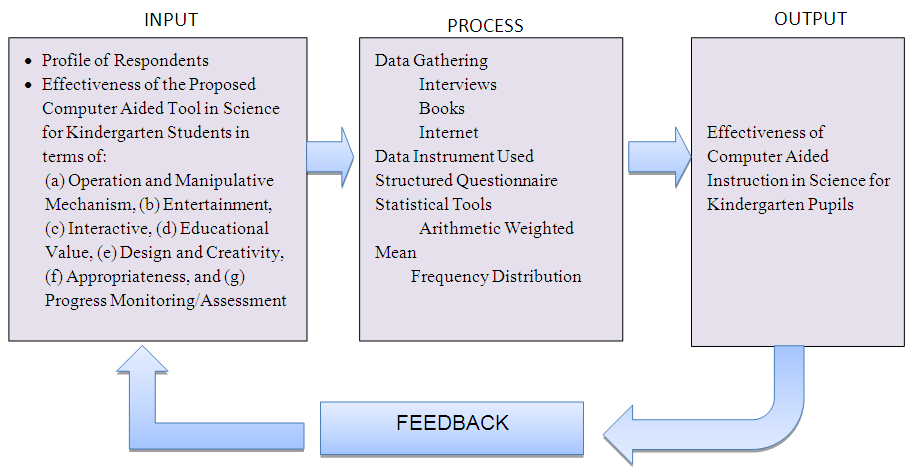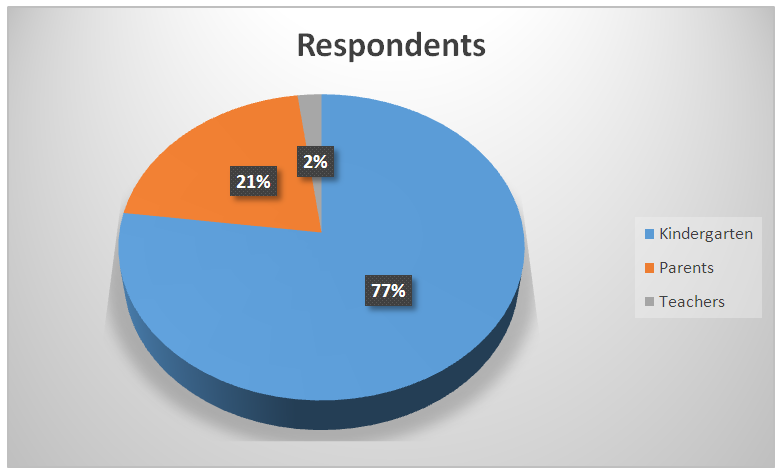-
Paper Information
- Paper Submission
-
Journal Information
- About This Journal
- Editorial Board
- Current Issue
- Archive
- Author Guidelines
- Contact Us
Computer Science and Engineering
p-ISSN: 2163-1484 e-ISSN: 2163-1492
2017; 7(2): 45-51
doi:10.5923/j.computer.20170702.02

Computer Aided Tool in Science for Kindergarten Pupils
Nemia M. Galang, Eric G. Galang
Ramon Magsaysay Technological University, Philippine
Correspondence to: Nemia M. Galang, Ramon Magsaysay Technological University, Philippine.
| Email: |  |
Copyright © 2017 Scientific & Academic Publishing. All Rights Reserved.
This work is licensed under the Creative Commons Attribution International License (CC BY).
http://creativecommons.org/licenses/by/4.0/

The learning program for Kindergarten is implemented by way of diverse learning activities that may be enhanced with the used of technologies and as one of the responses to meet the growing need for high quality education. The use of instructional learning materials and other resources that are locally developed and available is encouraged. Teaching Kindergarten has some problems that teachers are good to be aware of. Before deciding to teach Kindergarten, know yourself if you have the ability to not only to enforce behavioral rules but also to handle the stress and disorder that accompanies pupils’ behavioral problems. The main objective of the study is to evaluate the level of effectiveness of the proposed computer aided instruction entitled “Computer Aided Tool in Science for Kindergarten Education” according to the perception of the respondents. As the major step in the proposed research study computer aided instruction, the researcher used the descriptive research design and random sampling method. The statistical tools such as frequency distribution, percentage distribution and the weighted arithmetic mean were utilized in order to analyse and interpret the data gathered. T-test was also used to determine if there exist a significant difference on the level of effectiveness of the proposed system according to classification of the respondents. As to the level of effectiveness of the proposed computer aided instruction as to the teachers’ respondents they rated 4.71, which is interpreted as Highly Effective in terms of the entire criterion used while according to pupils’ respondents, they rated 4.81 with is interpreted as Highly Effective. The hypothesis tested between the two classifications of the respondents is -0.15, describes that there is no significant difference between the two classifications of respondents. The proposed system provides technology enhanced learning in science that leads Kindergarten pupils develop the foundation necessary for the future academic success.
Keywords: CAI, Instructional Tool, Learning, Teaching Kindergarten, Science
Cite this paper: Nemia M. Galang, Eric G. Galang, Computer Aided Tool in Science for Kindergarten Pupils, Computer Science and Engineering, Vol. 7 No. 2, 2017, pp. 45-51. doi: 10.5923/j.computer.20170702.02.
1. Introduction
- Due to the advancement of technology, the mode of teaching has changed from physical learning to virtual learning environment or known as e-learning. The e-Learning exploits interactive technologies and communication systems to improve the learning experience. It has the potential to transform the way we teach and learn across the board. It can raise standards, and widen participation in lifelong learning. It cannot replace teachers and lecturers, but alongside existing methods can enhance the quality and reach of their teaching.According to some research studies, children who underwent Kindergarten have better completion rates than those who did not. Children who complete a standards-based Kindergarten program are better prepared, for primary education.The learning program for Kindergarten is implemented by way of diverse learning activities that may be enhanced with the used of technologies and as one of the responses to meet growing need for high quality education. The use of instructional learning materials and other resources that are locally developed and available is encouraged.Teaching Kindergarten has some problems that teachers are good to be aware of. Before deciding to teach Kindergarten, determine if you have the ability to not only to enforce behavioral rules but also to handle the stress and disorder that accompanies pupils’ behavioral problems. Pupils at such a young age can have difficulty paying attention for a significant period of time. One of the obstacles the teacher will have to face is that of holding pupils attention and interest to the lessons. Especially with a large class size, it may be difficult to keep everyone’s focus on a specific activity all the time. This can be frustrating, but you must accept it.As observation, today children are exposed to advanced technology at an early age, with tablets, e-readers, and mobile phones being some prevalent choices. Experiences with technology can pave the way for unprecedented learning opportunities. However, without an education component, technology cannot reach its full potential for supporting children’s learning and development. In early childhood programs, the education component often means adults being nearby, interacting with children and providing opportunities for peer-to-peer learning to encourage children to gain the skills they need for succeeding in school.With this problem and observation, motivates the proponents came up with the decision of conducting this study. The development of the “Computer Aided Tool in Science for Kindergarten Pupils” will provide advanced learning tool for developing skills needed to prepare Kindergarten pupils for Grade 1 and catch their attention and interest especially in Science.The proposed application system is consisting of different kinds of lesson that will be based from the Kindergarten textbooks. The activities in this computer aided tool are based on Kindergarten instructional goals which are the essential skills that encourages creativity, reasoning and problem solving. The system also provides enjoyable and charming illustration with video clippings. The pictures used in the application are embedded with sounds that will add an extra dimension to critical thinking of pupils allowing them to make assumptions and draw conclusions about what is happening. Conceptual FrameworkThis study was anchored on the vision of developing an e-learning system in subject for Kindergarten education that will enhance the pupils’ skills needed to prepare them for Grade 1 especially in science subject. A diagram that best illustrates the conceptual framework of the study is shown in Figure 1.
 | Figure 1. Conceptual Paradigm of the Study |
2. Methodology
- The descriptive method of research was used for this study. According to the Creswell, he stated that the descriptive method of research is to gather information about the present existing condition. The emphasis is on describing rather than on judging or interpreting. Descriptive research on the other hand is a type of research that is mainly concerned with describing the nature or condition and the degree in the detail of the present situation. This method is used to describe the nature of a situation, as it existed at the time of the study and to explore the cause of particular phenomenon. The aim of descriptive research is to obtain an accurate profile of the people, events or situations.Sampling TechniqueRandom sampling was used, in this technique, each member of the population has an equal chance of being selected as subject. The entire process of sampling is done in a single step with each subject selected independently of the other members of the population.Sample size
|
 | Figure 2. Graphical Representations of the Respondents |
 | Figure 3. Waterfall Method |
|
3. Conclusions
- After the presentation, analysis, and interpretation of all data gathered, the proponents have come up with the following conclusions: 1. As to the level of effectiveness of the proposed computer aided tool, the respondents rated Highly Effective in terms of the entire criterion used. 2. The proposed computer aided tools provides technology to improve learning in science that leads Kindergarten pupils develop the foundation necessary for the future academic success. 3. The system helps to meet the goal of K To 12 program on learning development with advanced learning system. 4. Provides new opportunities to the teaching and learning process because it is a useful tool. 5. The computer aided instruction is appropriately developed for Kindergarten education.
4. Recommendations
- In light of all the conclusions drawn, the proponents hereby make the following recommendations: 1. The proposed computer aided instruction should be implemented to help the teachers improve their teaching process to their pupils. 2. That continuous development of the computer aided instruction should be undertaken to be able to adapt to the constantly improving trends in Information Technology. 3. That this computer aided instruction should not only be limited to the Kindergarten pupils but should also be introduced to other grade levels, considering as one of the support tools in learning science.
 Abstract
Abstract Reference
Reference Full-Text PDF
Full-Text PDF Full-text HTML
Full-text HTML
